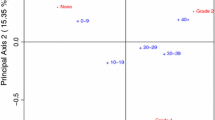Abstract
Intersection matrices help identify the common graphical structure of two or more objects. They arise naturally in a variety of settings. Several examples of their use in a computer algebra environment are given. These include: simplifying an expression involving array products, automating cumulant calculations, determining the behaviour of an expected value operator and identifying model hierarchy in a factorial experiment. The emphasis is placed on the graphical structure, and the symmetry of arrays help reduce the complexity of the graphical problem.
Similar content being viewed by others
References
Andrews D.F. 1998. Asymptotic expansions of moments and cumulants. U. Tor. Tech. Rep.
Andrews D.F. and Stafford J.E. 2000. Symbolic computation for statistical inference, Oxford University Press: Oxford.
Andrews D.F. and Stafford J.E. 1998. Iterated full partitions. J. Statist. & Comp, 8: 189-192.
Bellhouse D.R., Philips R., and Stafford J.E. 1997. Symbolic operators for multiple sums. J. Comp. Statist. & Data Anal. 24: 443-454.
Garey and Johnson. (1990). Computers and intractability: A guide to the theory of NP-completeness.
Kendall W.S. 1994. Computer algebra and yoke geometry I: When is an expression a tensor? Warwick University Technical Report.
Lee J. 1997. Ricci:Amathematica package for doing tensor calculations in differential geometry. U. Wash. Tech. Rep.
McCullagh P. 1987. Tensor Methods in Statistics. Chapman & Hall, New York.
McCullagh P. 2000. Invariance and factorial models. J. Roy Statist. Soc. 62: 209.
McCullagh P. and Wilks A. (1988). Complementary set partitions. Proc. Ro. Soc. London Ser. A.415: 347-362.
McKay B. 1991. Nauty user's guide. Dep. of Computer Science, Australian National University Tech. Report TR-CS-90-02.
Smith B. and Field C. 1998. Symbolic cumulant calculations for frequency domain time series. Dal. Univ. Tech. Rep.
Stafford J.E. 1994. Automating the partition of indexes. J. Comp. Graph. Statist. 3: 249-260.
Stafford J.E. 1998. A note on automating asymptotic expansions using Newton-Raphson. Univ. of Western Ontario Tech. Rep.
Wolfram S. 1996. The Mathematica Book,3rd ed. Cambridge Univ. Press.
Author information
Authors and Affiliations
Rights and permissions
About this article
Cite this article
Stafford, J.E. Using intersection matrices to identify graphical structure. Statistics and Computing 11, 47–55 (2001). https://doi.org/10.1023/A:1026557832181
Issue Date:
DOI: https://doi.org/10.1023/A:1026557832181




